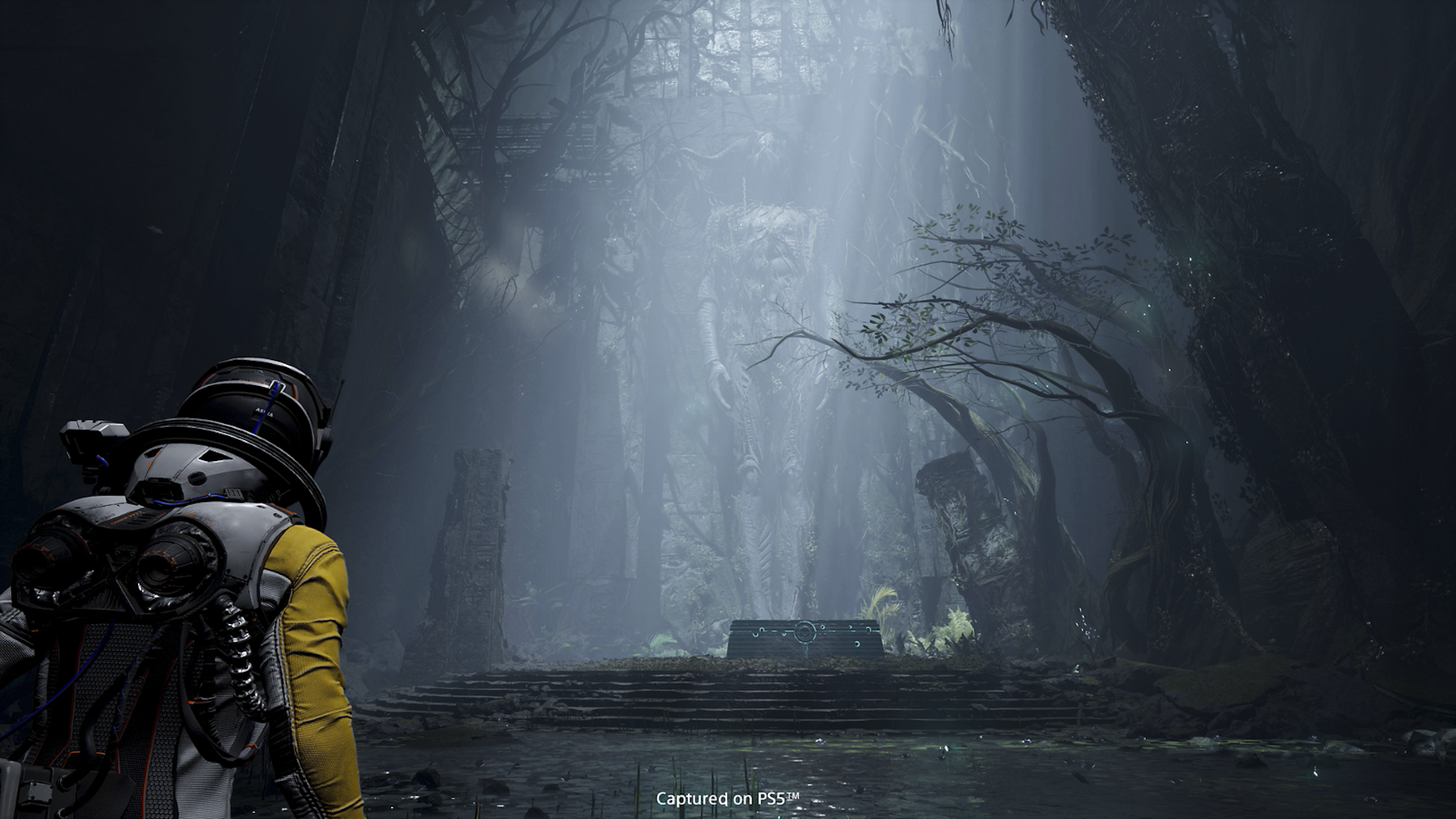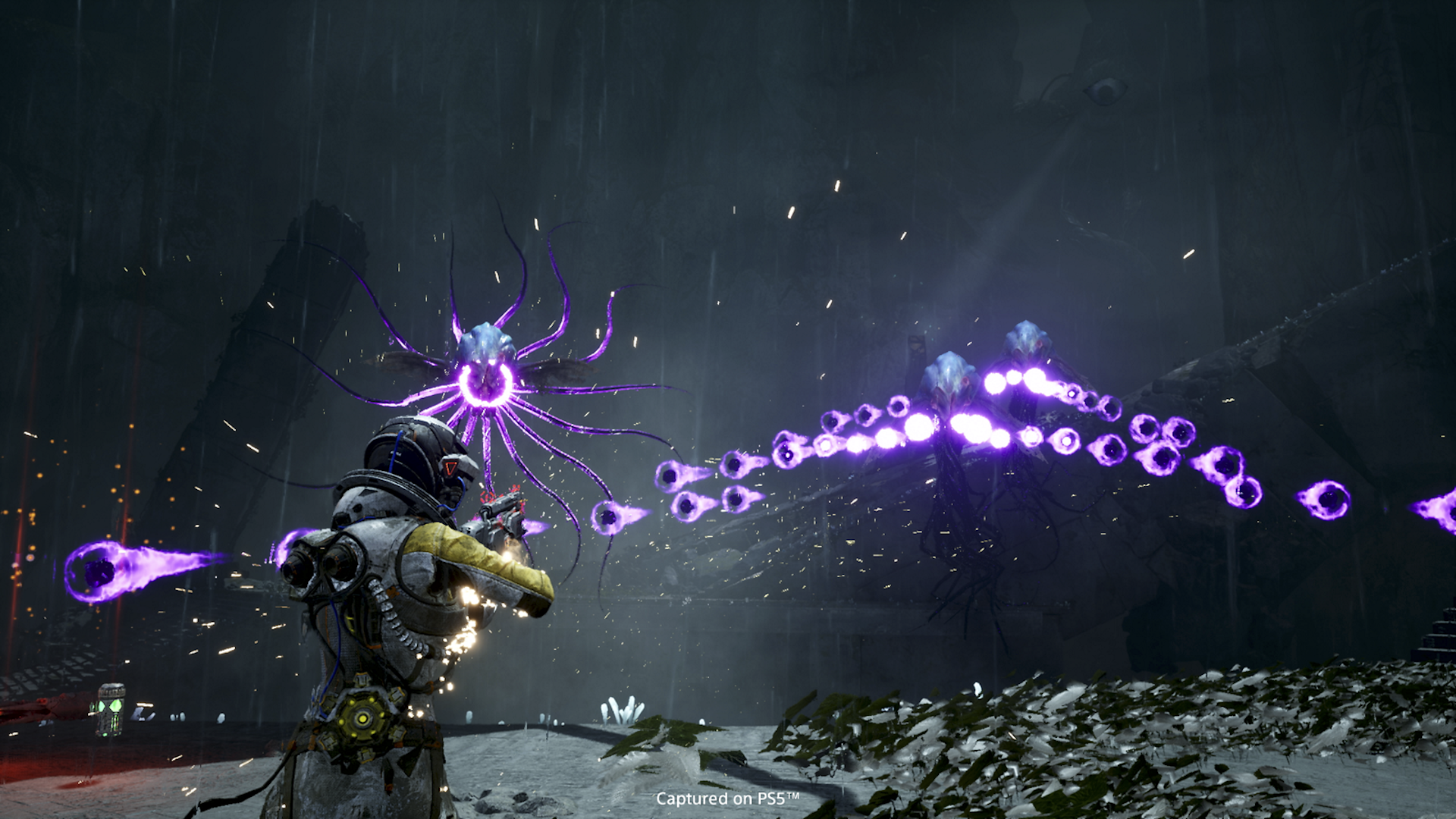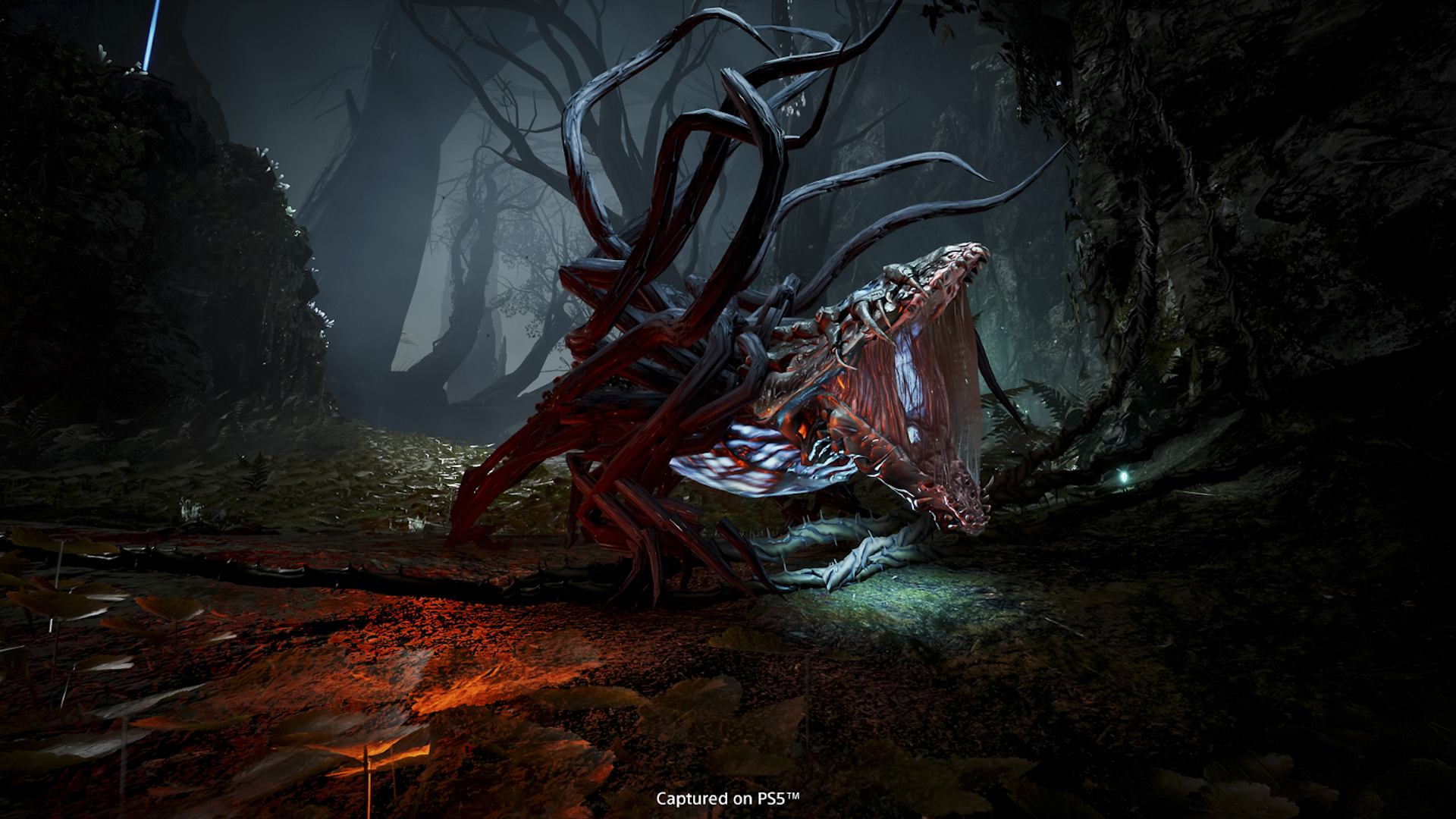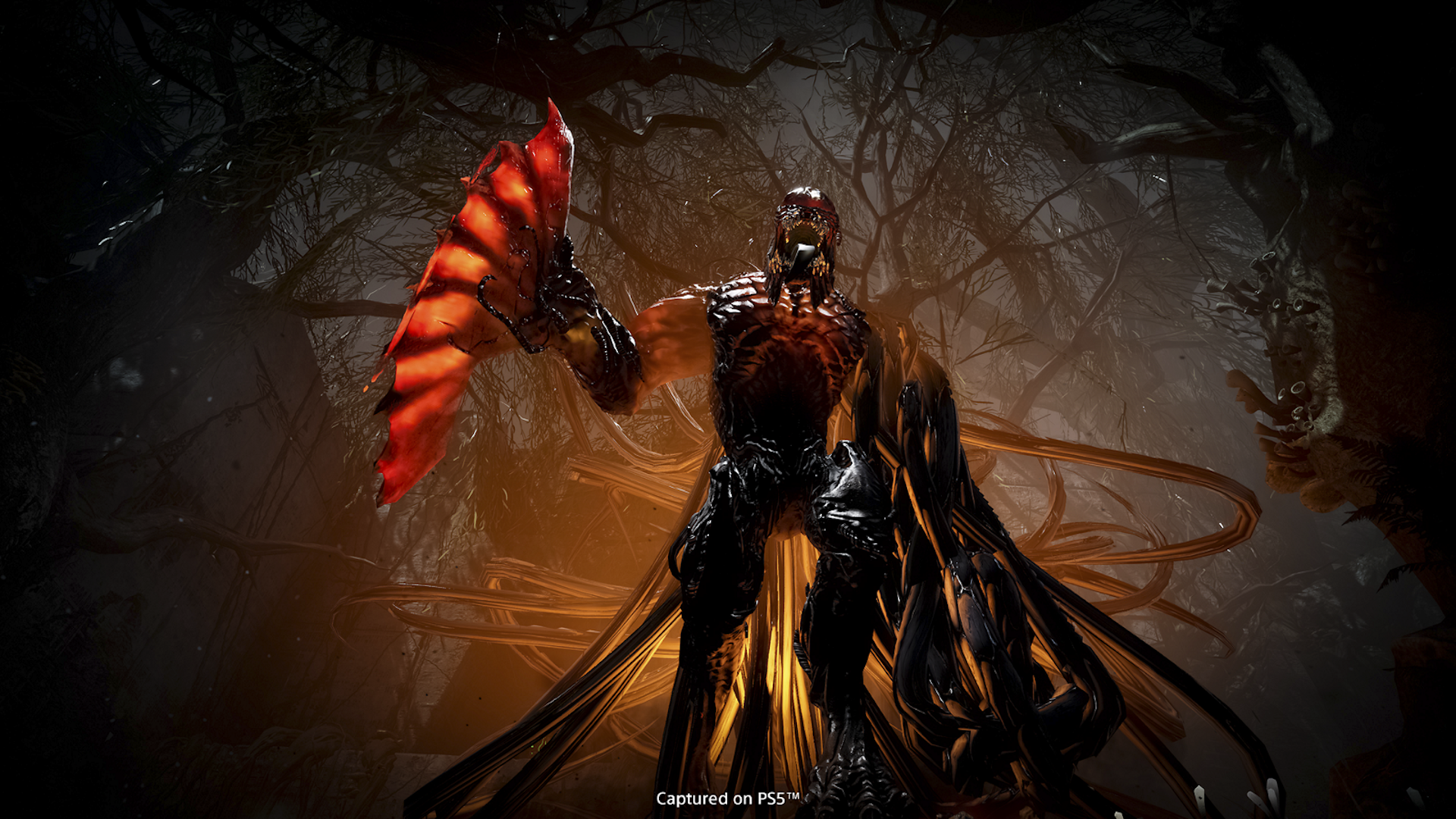- Game: Returnal
- Developer: Housemarque
- Publisher: Sony Interactive Entertainment
- Available on: PlayStation 5
- Reviewed on: PlayStation 5
The roguelike genre is one that I generally steer clear of. Its randomized and punishing nature has an appeal for many that I’ve understood, but it’s always pushed me away. Enter Returnal, a new AAA-roguelike from developer Housemarque that’s not only managed to catch my interest, but make me a newfound fan of the genre.
Set on the planet Atropos, you play as Selene, an astronaut who comes to the planet searching for an unknown signal. After her ship crashes, she awakes and finds herself stuck in an endless loop that resets every time she dies. With just a pistol in hand and her wits about her, Selene sets off to find a way out this cycle of death.
It’s a simple premise, but the game’s story quickly adds more layers to it, namely Selene’s life on Earth. During a run, you’ll encounter Selene’s home multiple times. Whenever you come across it, you enter a first-person perspective as you delve into her history prior to this journey. These cryptic sequences are genuinely creepy and nerve-wracking, making the sight of an astronaut something I was actually afraid of.
As you explore, you’ll also come across audio logs left with bodies from Selene’s previous runs. In addition to giving an idea of her mental state during these past attempts, each of these recordings offer a bit of backstory on Atropos, shedding some light on things, while also raising more questions. Alien glyphs and holographs are scattered across the planet as well, and they provide more tidbits of information about the planet’s history. I didn’t expect to find myself crawling down the rabbit hole, but I found it all to be truly fascinating. The mystery behind the game’s story, as well as the how and why of everything that’s happening had me intrigued and eagerly seeking out answers to these questions.

In addition to being a roguelike, Returnal also takes some inspiration from Metroidvanias. During your runs, you’ll come across Atropian items that can be integrated with Selene’s suit as permanent upgrades. These items allow you to reach areas that were previously unavailable, revealing secrets that were once out of reach and making combat encounters a bit easier. This encouraged me to fully explore each biome instead of just making a beeline straight for the boss room, a task that was made easier thanks to the helpful map and multiple fast travel points that can get you around almost instantly. Due to the randomized nature of the room layouts though, it’s impossible to find everything in just a few runs, so I haven’t discovered everything yet. This incentive to keep playing is great, and I’ve been having fun going back since I first rolled credits to find more items and piece together the true story behind Atropos and Selene.
What also makes everything about the story so engrossing is the world of Atropos itself. Made up of six different biomes, it’s equal parts awe-inspiring and unsettling, with a world design that gave me heavy Alien and Lovecraft vibes. Every biome has its own unique aesthetic that makes them each feel different from one another. The dark and foreboding forest you start in feels like something straight out of a horror movie, whereas the desert in the second biome is more open and feels a bit more freeing. Returnal’s score also adds to the atmosphere of each biome. The ambient music is haunting and ominous, and kept me on my toes at all times. With all of these different elements coming together, it was hard to shake the oppressive feeling of death and constant danger that Atropos instilled in me, regardless of the area I was in.
The DualSense contributes to the feel of Atropos as well. Housemarque does some very clever and cool things with the haptic feedback in the controller to make you feel like a part of the world. It can be something minor like feeling light taps in the controller as rain hits Selene’s suit, or something more major like the pulsating vibration that triggers when standing on a teleporter. Combine that with the haptics also creating an otherworldly sound, and it makes the teleporter feel alive and not like an inanimate object. These additions show the DualSense’s potential to truly immerse you in a game world, and I’m hoping more developers take note of Housemarque’s implementation here.

This would all be naught if Returnal wasn’t fun to play, and trust me when I say that it’s a lot of fun. A large part of why is because of the difficulty, something that’s inherent to the roguelike genre. Much has been made of how tough the game is, and I do agree that it’s pretty challenging. That being said, I didn’t find the game to be an absolutely brutal experience along the lines of a Souls-like. It took me just under 11-hours to hit the credits, and including the first unavoidable death in the game, I only died a total of three times. Even still, there were a lot of close calls in the lead-up to finishing the story, and I’ve died some more after going back to find more of the game’s secrets.
The challenge comes from different places, with one of them being how lucky you are on any given run. With every new run, you always start with just your pistol and any permanent unlocks you’ve earned along the way. All other buffs and weapons are lost upon death. If you’re able to consistently find good weapons throughout the run, you’ll have a fairly challenging time, but nothing too overbearing. Get the short end of the stick, and you’re in for an uphill battle.
There’s a nice variety of weapons on hand for you to use, and each one comes with their own set of perks that are randomized each time you find them. These perks get unlocked by using the weapons, and once earned, they’re permanently available across multiple runs. Weapon proficiency also affects the level of the weapons that you discover, with higher proficiency weapons having better perks. I found myself using multiple different weapons during my runs not just because they each have their own uses, but also to unlock their different perks so that I would have better versions available to me at a later point.
My personal favorite weapon was the Electropylon Driver which shoots out electrified pylons that stick around for a bit. With it, I could cover an area with them as a defensive measure, or attach them to multiple enemies to damage them all at the same time. This was my go-to weapon during runs, but there are still others that I like to use and more that I still want to give a try.
Once again, the DualSense comes into play here with its adaptive triggers. Every gun has a main fire and an alternate fire ability. Hold down L2 halfway and you’ll aim and do your main fire. Press down fully on the trigger and you’ll activate your alternate ability. It’s a unique and cool feature that added another level of immersion which I was fond of.

Your weapon isn’t the only thing that’ll determine how tough your run is. As you play, you’ll come across different items that can change the experience for you. Artifacts give you a buff that lasts for the duration of your run and can certainly make the difference in tough encounters. Parasites latch onto your suit, offering you some sort of benefit while you have them, while giving you a debuff at the same time. Malignant items give you some sort of reward, but at the risk of causing a suit malfunction that penalizes you until a certain condition is fulfilled.
The gambling act that’s played with the latter two is consistently thrilling and had me constantly weighing the risk of a nice perk against a potentially crushing consequence. Being stacked up with artifacts and parasites can make you very powerful, especially in combination with a good weapon, making some of the later enemy encounters much easier to handle.
You’ll want to be as prepared for fights as possible because they don’t pull any punches. Digging into Housemarque’s arcade-style roots, fights are fast-paced, energetic affairs that very quickly turn into a bullet hell fight for your life. Enemies send all sorts of projectiles at you, leaving you to bob and weave your way up, down, and all around them as best you can, while eliminating your attackers at the same time. I would be lying if I said that it wasn’t overwhelming at times, though it’s nothing completely unmanageable.
This is especially true during boss fights, where the screen ends up covered in a colorful barrage of projectiles for you to dance around. The music amplifies battles as well by turning up the intensity to get you in the zone. Although I didn’t die much on my way to the credits, there were a lot of times where I made it out of a fight by the skin of my teeth, and I absolutely relished those victories every single time. When you do die, the game gets you back to the action pretty quickly thanks to some seriously impressive load times, so you’re never waiting too long after death to keep on playing.

What I feel contributes the most to Returnal’s difficulty is actually the length of the runs. They aren’t short and can take multiple hours to complete, making it really punishing to die hours into one and have to start all over. Perhaps more egregious is the fact that you aren’t able to save your progress and quit whenever you want. When you first start up the game, you’re greeted with a message that says the only way to keep your progress during a run is to put the console in Rest Mode. If you quit mid-run, any progress you made is wiped and you have to start all over again. Using Rest Mode is a solution for if you want to take a break from the PS5 or need to step away from your system for a bit, but it doesn’t solve the problem of if you want to do anything else on your console or even just turn it off.
You’re essentially locked in to playing Returnal once you start, and that’s not ideal. It’s annoying that the only choices available for saving progress are either finishing a run or dying after hours of progress and starting from scratch again. At the time of writing, Housemarque has said that they acknowledge the community’s complaints, but have yet to say whether or not a “save and quit” option is in the works, though I sincerely hope that one is. It would definitely go a long way towards making the game more accessible to those who don’t want it to be the only thing they can do once they start playing.
Overall
Returnal is a stellar title from Housemarque, especially when you consider that it’s not just their first PS5 game, but also their first AAA game. At $70, I can understand why some may be hesitant to spend that much money on what seems like a smaller, punishing experience, but it’s well worth the price. With exhilarating gameplay and an intriguing story to dig into, Returnal is one of the finest PlayStation exclusives so far this generation, and it shouldn’t be missed.